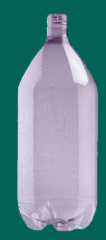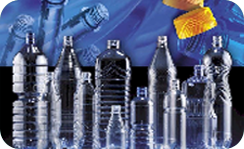Blow Molding: Reheat
Reheat Stretch Blow Molding (RSBM) is part of the two-stage process of making bottles from PET or other resins. During the first stage injection machines produce vial or test-tube shaped 'preforms'. The necks of preforms are fully finished but the diameter and length is much smaller than the bottle into which it will be transformed during the RSBM process. During this transformation the material undergoes significant changes in molecular orientation making PET bottles virtually unbreakable, lightweight, and enhancing various barrier properties while keeping the clarity that is also present in the preforms.
PET bottle production has enjoyed tremendous success over the last twenty years. In 2002 nine million tons of PET resin worldwide were converted into containers and PET still enjoys the highest growth rate of any major plastic.
There are three different ways of making a PET bottle: the single-stage, integrated two-stage, and two-stage process.
Sidel, SIG, Krones, Smiform, and SIPA have all developed rotary machines while there more than a dozen manufacturers of linear machines for smaller outputs. Competitive pressure has driven prices down, opening new applications for bottle blowing. Blow molding speeds have also driven costs down: While 1,000 bottles/cavity/hour was the benchmark for many years, today's machines feature outputs of up to 1,650 bottles/cavity/hour.
 The first 'killer application' for PET was the 2-litre bottle for carbonated soft drinks (CSD), introduced in 1978. The first bottles featured a dome-shaped bottom ideally suited to sustain internal pressures that routinely reach 5 bar (70 PSI). This required an additional plastic component, called a base cup, to be glued to the bottom in a secondary operation in order for the bottle to stand up. However, cost as well as recycling considerations (glue residue) encouraged the development of a one-piece bottle. The breakthrough came with the design of the so-called Petaloid base, a thick, mostly amorphous center disk surrounded by five blown feet. Granted as patent to the Continental Can Company in 1971, it caused controversy with 3 other patents and litigation ensued over several years. It took until the early nineties before one-piece bottles came off the conveyors of reheat stretch blow moulding machines and completely replaced two-piece bottles within a few short years.
The first 'killer application' for PET was the 2-litre bottle for carbonated soft drinks (CSD), introduced in 1978. The first bottles featured a dome-shaped bottom ideally suited to sustain internal pressures that routinely reach 5 bar (70 PSI). This required an additional plastic component, called a base cup, to be glued to the bottom in a secondary operation in order for the bottle to stand up. However, cost as well as recycling considerations (glue residue) encouraged the development of a one-piece bottle. The breakthrough came with the design of the so-called Petaloid base, a thick, mostly amorphous center disk surrounded by five blown feet. Granted as patent to the Continental Can Company in 1971, it caused controversy with 3 other patents and litigation ensued over several years. It took until the early nineties before one-piece bottles came off the conveyors of reheat stretch blow moulding machines and completely replaced two-piece bottles within a few short years.
By the mid-nineties, soft drink companies agreed to lower shelf life requirements and so opened the way for the extremely successful launch of 20 oz and 500 ml. containers.
Blow Molding: Reheat
At the time of writing in early 2003, it is water and a whole new line of beverages that did not even exist a few years ago that are the key drivers for PET growth. Hot-fill juices and so-called Neutraceuticals have raised the demands imposed on today's PET bottles and the industry has responded with a wealth of new technologies. Recent developments aim to eliminate the unsightly vacuum panels needed for controlled shrinkage of the PET bottle during cooling of a hot-filled product. Multi-layer preforms and coating technologies increase shelf life and so will open the way for even smaller CSD packages and the replacement of glass in a new set of applications. At this time it is unclear whether coatings or multi-layer technologies will prevail as the preferred choice of packaging, but it is this author's opinion that a variety of methods will be called for, to meet an ever-increasing variety of packaging demands.
My services in this area include training of plant and office personnel, trouble-shooting of process problems, getting you started in manufacturing, as well as product development.
OB Plastics Consulting
18 Caribou Trail
Wasaga Beach ON L9Z1H8 Canada
Tel.: 705-429-1492
Fax: 419-844-7759

 The experts at Apex Container Tech Inc. are here to assist you in your current business or with starting a new one
The experts at Apex Container Tech Inc. are here to assist you in your current business or with starting a new one
 The experts at Apex Container Tech Inc. are here to assist you in your current business or with starting a new one
The experts at Apex Container Tech Inc. are here to assist you in your current business or with starting a new one







 The first 'killer application' for PET was the 2-litre bottle for carbonated soft drinks (CSD), introduced in 1978. The first bottles featured a dome-shaped bottom ideally suited to sustain internal pressures that routinely reach 5 bar (70 PSI). This required an additional plastic component, called a base cup, to be glued to the bottom in a secondary operation in order for the bottle to stand up. However, cost as well as recycling considerations (glue residue) encouraged the development of a one-piece bottle. The breakthrough came with the design of the so-called Petaloid base, a thick, mostly amorphous center disk surrounded by five blown feet. Granted as patent to the Continental Can Company in 1971, it caused controversy with 3 other patents and litigation ensued over several years. It took until the early nineties before one-piece bottles came off the conveyors of reheat stretch blow moulding machines and completely replaced two-piece bottles within a few short years.
The first 'killer application' for PET was the 2-litre bottle for carbonated soft drinks (CSD), introduced in 1978. The first bottles featured a dome-shaped bottom ideally suited to sustain internal pressures that routinely reach 5 bar (70 PSI). This required an additional plastic component, called a base cup, to be glued to the bottom in a secondary operation in order for the bottle to stand up. However, cost as well as recycling considerations (glue residue) encouraged the development of a one-piece bottle. The breakthrough came with the design of the so-called Petaloid base, a thick, mostly amorphous center disk surrounded by five blown feet. Granted as patent to the Continental Can Company in 1971, it caused controversy with 3 other patents and litigation ensued over several years. It took until the early nineties before one-piece bottles came off the conveyors of reheat stretch blow moulding machines and completely replaced two-piece bottles within a few short years.

